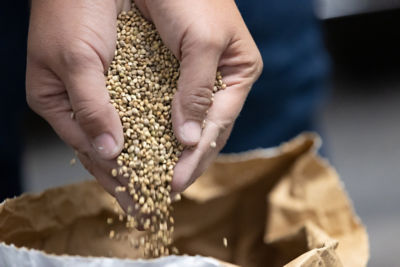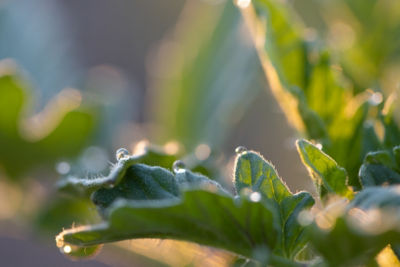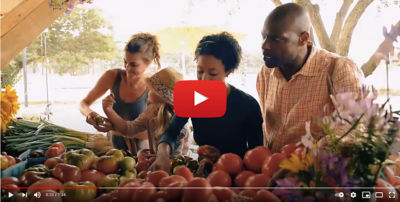Click here to download a PDF version of this spotlight.
» Fusarium wilt of lettuce can result in substantial reductions in crop yield potential.
» Symptoms of Fusarium wilt include yellowing of leaves, wilting, vascular discoloration, root rot, and plant death.
» Management practices focus primarily on keeping inoculum soil levels low and using disease-resistant varieties with some lettuce types.
Fusarium wilt of lettuce is caused by the fungal pathogen Fusarium oxysporum f.sp. lactucae. Although it can colonize other hosts, this pathogen is only known to cause disease in lettuce. It was first documented in the U.S. in 1990 in California and appeared shortly after in Arizona. Fusarium wilt of lettuce was first reported in Florida in 2017. Four races of this pathogen have been identified, but only Race 1 has been found in the U.S.1,2
SYMPTOMS
The symptoms of Fusarium wilt can vary depending on the lettuce variety’s susceptibility, the level of inoculum in the soil, and the air and soil temperatures. The fungus infects through secondary roots and colonizes the taproot’s xylem (water conducting tissue). Xylem infection slows the flow of water and nutrients to the upper plant, and above-ground symptoms result from the reduced availability of water and nutrients.
Above-ground symptoms include wilting of leaves, stunting, and chlorosis (yellowing), eventually leading to leaf necrosis and plant death (Figure 1).2,3 Stunting can be severe, and affected plants may fail to produce heads. On older plants, the yellowing of leaves can be accompanied by tip burn, and a brown to black discoloration of the leaf’s vascular tissue can develop.4 Few or no symptoms may develop on the above ground plant parts even when the root system is heavily infected.3 Seedlings can also wilt and die. Infected roots typically show a reddish-brown discoloration of the cortex of the crown and upper tissues of the taproot. The core of the taproot can be extensively rotted.1,4
 Figure 1. Foliar symptoms of Fusarium wilt on lettuce seedlings, including yellowing, wilting, and seedling death.
Figure 1. Foliar symptoms of Fusarium wilt on lettuce seedlings, including yellowing, wilting, and seedling death.
Symptoms of Fusarium wilt are similar to several other diseases, including Verticillium wilt, lettuce drop caused by Sclerotinia sclerotiorum and S. minor, gray mold, bacterial soft rot, and corky root rot. All of these diseases can result in stunting and plant collapse. The reddish-brown discoloration of the taproot tissue is one of the most distinguishing features of Fusarium wilt on lettuce.2,3,4
DISEASE CYCLE AND CONDITIONS
The Fusarium wilt pathogen is a soilborne fungus distributed in infested soil and crop debris. Inoculum can be moved by wind, flowing water, and on tools and equipment.1,2 Spores of the fungus have a half-life in the soil of about six months. However, once introduced into a field, the pathogen will most likely remain in the field indefinitely, surviving on the roots of various crop and weed plant species. Fusarium oxysporum f.sp. lactucae has been shown to colonize the roots of broccoli, cauliflower, and spinach, which are common rotational crops for lettuce. The level of colonization of these three crops varies, with broccoli being a fairly poor host. The pathogen can colonize cauliflower roots somewhat better, but the fungus was isolated from 50% of spinach plants exposed to inoculum.1,5 The pathogen can also extensively colonize the root systems of some lettuce varieties characterized as resistant to Fusarium wilt. The severity of above-ground symptoms is not always well correlated with the level of root colonization. This means that the inoculum levels of the Fusarium wilt pathogen can increase in a field planted with a resistant variety of lettuce.5 Local spread is mainly through the movement of infested soil or crop debris. Long-distance distribution is thought to be primarily through infested seeds.1,3
Disease development and symptom expression are affected by inoculum density and temperature. Therefore, higher levels of the pathogen in the soil are correlated with higher disease incidence and severity. Symptoms are also more severe during periods with high temperatures (91/72°F day/night) as compared to low-temperature periods (74/64°F day/night).1,3 In California, Fusarium wilt on lettuce crops planted in June has been more severe than on crops planted in July and August because of the temperatures that occur during the primary stages of production.
MANAGEMENT
Avoid planting susceptible lettuce varieties in fields with a history of Fusarium wilt for at least three years after the last lettuce crop. Avoid introducing the pathogen into non-infested fields by using only disease-free seeds and proper sanitation practices. Do not use seeds that are contaminated with soil or crop debris. Chemical seed treatments may provide some protection against seedborne inoculum. Clean equipment and tools between fields to prevent the movement of soil between fields. It can take several years for the pathogen to build up to levels where symptoms become apparent, so cleaning equipment after use, even in fields with no history of the disease, is recommended.1,2,3,4
For fields with a history of Fusarium wilt on lettuce, several strategies can help lower inoculum levels. One strategy is soil solarization, a process in which soils are covered with clear plastic to capture solar radiation and increase the temperature of the soil. Solarization is typically done during the warmest time of the year.1,3 A study performed in Arizona in 2010 found that soil solarization reduced inoculum levels of the lettuce Fusarium wilt pathogen by 91%. In that study, soil temperatures at a depth of two inches were raised to as high as 120°F (49°C).6 Soil fumigation is a strategy used to help manage Fusarium wilt in other crops, such as tomatoes, and it might help manage the disease on lettuce. However, soil fumigation is expensive and not economically feasible for most lettuce production operations.1,3 Fallowing fields can also help lower the inoculum level of the wilt pathogen, but the practice will probably not result in the complete elimination of the pathogen. One study showed a rapid decline in the level of Fusarium oxysporum f.sp. lactucae in the first year of fallowing but a slower decline thereafter. The pathogen was still detectable in the soil two and a half years after the last lettuce crop.3 In fields where Fusarium wilt has been identified, rotate to non-host crops for at least three years. Rotations should not include brassicas or spinach, and resistant lettuce varieties should not be considered as a non-host crop.1,2,4
 Figure 2. A lettuce trial in a soil with high levels of Fusarium inoculum showing some crisphead varieties with intermediate resistance (IR) to Fusarium wilt.
Figure 2. A lettuce trial in a soil with high levels of Fusarium inoculum showing some crisphead varieties with intermediate resistance (IR) to Fusarium wilt.
Time plantings to avoid having the primary production period during the warmest times of the year. It is especially important to grow the most susceptible lettuce varieties during the coolest parts of the growing season.1,2,3 Some lettuce varieties are characterized as having resistance to Fusarium wilt. High resistance levels are present in some leaf and romaine lettuce varieties.1,3 Historically, there have not been effective levels of resistance in crisphead varieties; however, recent breeding efforts by seed companies have improved the levels of resistance in some crisphead varieties to the point that they are becoming comparable to levels in the loose leaf and romaine types (Figure 2). The evaluation of resistance to Fusarium wilt is sometimes based only on the expression of symptoms on above-ground parts of the lettuce plant, not on symptoms on the roots or levels of pathogen colonization of the roots.1,3 Selecting resistant varieties that also show lower colonization of the root system helps to minimize the buildup of pathogen inoculum when lettuce crops are grown. Currently, only Race 1 of the Fusarium wilt pathogen has been found in the U.S., but Races 2, 3, and 4 are present in other areas of the world. Taking steps to minimize the long-distance dispersal of the Fusarium wilt pathogen will help prevent the introduction of new races and protect the effectiveness of the resistance genes available in some lettuce varieties.3
SOURCES
1 Gordon, T. and Koike, S. 2017. Fusarium wilt. In: Compendium of Lettuce Diseases and Pests, 2nd Ed. Subbarao, K., Davis, M., Gilbertson, R., and Raid, R. eds. The American Phytopathological Society, St Paul.
2 Sandoya, G. Murray, J., Raid, R., and Miller, C. 2020. Fusarium wilt: a new threat to Florida lettuce production. UF-IFAS Extension. University of Florida, publication HS1385. https://edis.ifas.ufl.edu/publication/HS1385.
3 Gordon, T. and Koike, S. 2015. Management of Fusarium wilt of lettuce. Crop Protection 73:45-49.
4 Koike, S. and Turini, T. 2017. Fusarium wilt. UC-IPM. Lettuce Pest Management Guidelines. https://www2.ipm.ucanr.edu/agriculture/lettuce/fusarium-wilt/.
5 Scott, J. C., McRoberts, D. N., and Gordon, T. R. 2014. Colonization of lettuce cultivars and rotation crops by Fusarium oxysporum f. sp. lactucae, the cause of Fusarium wilt of lettuce. Plant Pathology 63:548-553.
6 Matheron, M. and Porchas, M. 2010. Evaluation of soil solarization and flooding as management tools for Fusarium wilt of lettuce. Plant Disease 94:1323-1328.
Websites verified 8/10/2022
ADDITIONAL INFORMATION
For additional agronomic information, please contact your local seed representative.
Performance may vary from location to location and from year to year, as local growing, soil and weather conditions may vary. Growers should evaluate data from multiple locations and years whenever possible and should consider the impacts of these conditions on the grower’s fields. The recommendations in this article are based upon information obtained from the cited sources and should be used as a quick reference for information about vegetable production. The content of this article should not be substituted for the professional opinion of a producer, grower, agronomist, pathologist and similar professional dealing with vegetable crops.
BAYER GROUP DOES NOT WARRANT THE ACCURACY OF ANY INFORMATION OR TECHNICAL ADVICE PROVIDED HEREIN AND DISCLAIMS ALL LIABILITY FOR ANY CLAIM INVOLVING SUCH INFORMATION OR ADVICE. 5911_63451 Published 09/16/2022
Bayer, Bayer Cross, and Seminis® are registered trademarks of Bayer Group. All other trademarks are property of their respective owners. © 2022 Bayer Group. All rights reserved.




